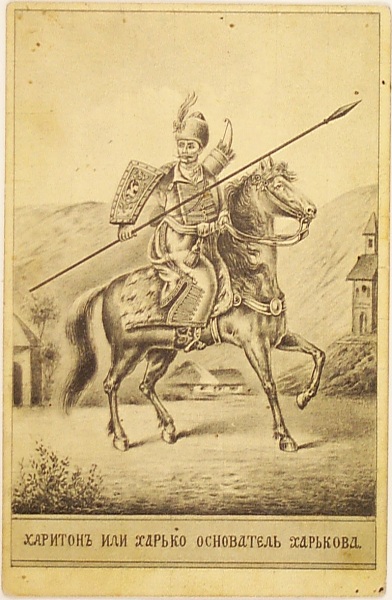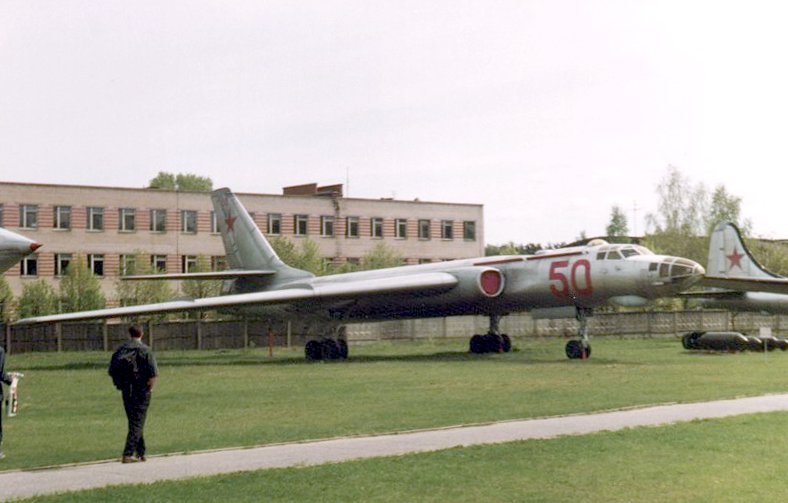|
Tu-134
The Tupolev Tu-134 (NATO reporting name: Crusty) is a twin-engined, narrow-body jet airliner built in the Soviet Union for short and medium-haul routes from 1966 to 1989. The original version featured a glazed-nose design and, like certain other Russian airliners (including its sister model, the Tu-154), it can operate from unpaved airfields. One of the most widely used aircraft in former Comecon countries, the number in active service is decreasing because of operational safety concerns and noise restrictions. The model has seen long-term service with some 42 countries, with some European airlines having scheduled as many as 12 daily takeoffs and landings per plane. In addition to regular passenger service, it has also been used in various air force, army and navy support roles; for pilot and navigator training; and for aviation research and test projects. In recent years, a number of Tu-134s have been converted for use as VIP transports and business jets. A total of 854 Tu- ... [...More Info...] [...Related Items...] OR: [Wikipedia] [Google] [Baidu] |
Narrow-body Aircraft
A narrow-body aircraft or single-aisle aircraft is an airliner arranged along a single aisle, permitting up to 6-abreast seating in a cabin less than in width. In contrast, a wide-body aircraft is a larger airliner usually configured with multiple aisles and a fuselage diameter of more than , allowing at least seven-abreast seating and often more travel classes. Market Historically, beginning in the late 1960s and continuing through the 1990s, twin engine narrow-body aircraft, such as the Boeing 737 Classic, McDonnell-Douglas MD-80 and Airbus A320 were primarily employed in short to medium-haul markets requiring neither the range nor the passenger-carrying capacity of that period's wide-body aircraft. The re-engined Boeing 737 MAX and Airbus A320neo jets offer 500 miles more range, allowing them to operate the 3,000 miles transatlantic flights between the eastern U.S. and Western Europe, previously dominated by wide-body aircraft. Norwegian Air Shuttle, JetBlue and ... [...More Info...] [...Related Items...] OR: [Wikipedia] [Google] [Baidu] |
Sud Aviation Caravelle
The Sud Aviation SE 210 Caravelle is a French jet airliner produced by Sud Aviation. It was developed by SNCASE in the early 1950s, and made its maiden flight on May 27, 1955. It included some de Havilland designs and components developed for the de Havilland Comet, the first jet airliner. SNCASE merged into the larger Sud Aviation conglomerate before the aircraft entered revenue service on April 26, 1959, with Scandinavian Airlines System (SAS); 282 were built until production ended in 1972. It was ordered by airlines on every continent and operated until its retirement in 2005. The short-range, five-abreast airliner is powered by two aft-mounted Rolls-Royce Avon turbojet engines, allowing a clean low wing. The configuration was later retained in many narrow-body aircraft and regional jets. The initial I, III and VI variants could seat 90 to 99 passengers over . The later, slightly longer 10/11 variants could seat 99 to 118 passengers over and were powered by Pratt & Whitn ... [...More Info...] [...Related Items...] OR: [Wikipedia] [Google] [Baidu] |
Sochi International Airport
Sochi International Airport (; ) is an international airport located in the Adler District of the resort city of Sochi, on the coast of the Black Sea in the federal subject of Krasnodar Krai, Russia. Sochi International Airport is among the ten largest Russian airports, with an annual passenger turnover of 5.2 million. The airport is run by an international joint venture of Basic Element group, Sberbank and Changi Airports International. The airport has been recognized as the best regional airport at the 3rd annual forum "Development of Russia and CIS airports – 2013", held by Adam Smith Conference. Sochi International Airport was the main gateway during the 2014 Winter Olympics. It served over 350,000 passengers on February 1–28, 2014. Over 2,800 tons of luggage was handled during the Olympic period. As of 2024 it is the 5th busiest airport in Russia and Post-Soviet states. History 1941–1991 The original airfield was constructed to protect Russia's Black Sea coast ... [...More Info...] [...Related Items...] OR: [Wikipedia] [Google] [Baidu] |
Auxiliary Power Unit
An auxiliary power unit (APU) is a device on a vehicle that provides energy for functions other than propulsion. They are commonly found on large aircraft and naval ships as well as some large land vehicles. Aircraft APUs generally produce 115 V AC voltage at 400 Hz (rather than 50/60 Hz in mains supply), to run the electrical systems of the aircraft; others can produce 28 V DC voltage. APUs can provide power through single or three-phase systems. A jet fuel starter (JFS) is a similar device to an APU but directly linked to the main engine and started by an onboard compressed air bottle. Transport aircraft History During World War I, the British Coastal class blimps, one of several types of airship operated by the Royal Navy, carried a ABC auxiliary engine. These powered a generator for the craft's radio transmitter and, in an emergency, could power an auxiliary air blower. One of the first military fixed-wing aircraft to use an APU was the British, ... [...More Info...] [...Related Items...] OR: [Wikipedia] [Google] [Baidu] |
Kharkov
Kharkiv, also known as Kharkov, is the second-largest List of cities in Ukraine, city in Ukraine.Kharkiv "never had eastern-western conflicts" , ''Euronews'' (23 October 2014) Located in the northeast of the country, it is the largest city of the historic region of Sloboda Ukraine. Kharkiv is the administrative centre of Kharkiv Oblast and Kharkiv Raion. Prior to the Russian invasion of Ukraine in early 2022, it had an estimated population of 1,421,125. Founded in 1654 as a Cossacks, Cossack fortress, by late 19th century Kharkiv had developed within the Russian Empire as a major commercial and industrial centre. From December 1919 to January 1934, Kharkiv was the capital of the Ukrainian Soviet Socialist Rep ... [...More Info...] [...Related Items...] OR: [Wikipedia] [Google] [Baidu] |
Tupolev Tu-16
The Tupolev Tu-16 (USAF/DOD reporting name Type 39; NATO reporting name: Badger) is a twin-engined jet strategic heavy bomber used by the Soviet Union. It has been flown for almost 70 years. While many aircraft in Soviet service were retired after the Cold War ended, the Chinese license-built version Xian H-6 remains in service with the People's Liberation Army Air Force, with the most modern variant, the H-6K, still being actively produced . Development In the late 1940s, the Soviet Union was strongly committed to matching the United States in strategic bombing capability. The Soviets' only long-range bomber at the time was Tupolev's Tu-4 "Bull", a reverse-engineered copy of the American B-29 Superfortress. The development of the notably powerful Mikulin AM-3 turbojet led to the possibility of a large, jet-powered bomber. The Tupolev design bureau began work on the Tu-88 ("Aircraft N") prototypes in 1950. The Tu-88 first flew on 27 April 1952. After winning a competition ... [...More Info...] [...Related Items...] OR: [Wikipedia] [Google] [Baidu] |
Direct Current
Direct current (DC) is one-directional electric current, flow of electric charge. An electrochemical cell is a prime example of DC power. Direct current may flow through a conductor (material), conductor such as a wire, but can also flow through semiconductors, electrical insulation, insulators, or even through a vacuum as in electron beam, electron or ion beams. The electric current flows in a constant direction, distinguishing it from alternating current (AC). A archaism, term formerly used for this type of current was galvanic current. The abbreviations ''AC'' and ''DC'' are often used to mean simply ''alternating'' and ''direct'', as when they modify ''Electric current, current'' or ''voltage''. Direct current may be converted from an alternating current supply by use of a rectifier, which contains Electronics, electronic elements (usually) or electromechanical elements (historically) that allow current to flow only in one direction. Direct current may be converted into alt ... [...More Info...] [...Related Items...] OR: [Wikipedia] [Google] [Baidu] |
Drogue Parachute
A drogue parachute, also called drag chute, is a parachute designed for deployment from a rapidly moving object. It can be used for various purposes, such as to decrease speed, to provide control and stability, as a pilot parachute to deploy a larger parachute or a combination of these. Vehicles that have used drogue parachutes include multistage parachutes, aircraft, and spacecraft recovery systems. The drogue parachute was invented by Russian professor and parachute specialist Gleb Kotelnikov in 1912, who also invented the knapsack parachute. The Soviet Union introduced its first aircraft fitted with drogue parachutes during the mid 1930s; use of the technology expanded during and after the Second World War. A large number of jet-powered aircraft have been furnished with drogue parachutes, including the Boeing B-52 Stratofortress strategic bomber and the Eurofighter Typhoon multirole aircraft; they were also commonly used within crewed space vehicle recovery programmes ... [...More Info...] [...Related Items...] OR: [Wikipedia] [Google] [Baidu] |
1963 BAC One-Eleven Test Crash
The 1963 BAC One-Eleven test crash was a fatal accident of a British Aircraft Corporation prototype aircraft on 22 October 1963, near Chicklade in Wiltshire, England while it was undertaking a test flight. All seven crew members on board the BAC One-Eleven were killed. Accident The accident occurred during a test flight of the first prototype BAC One-Eleven (registration G-ASHG) which had taken off from Wisley Airfield with seven crew on board, captained by Mike Lithgow. The aircraft was on its fifth test flight to assess stability and handling characteristics during the approach to—and recovery from—a stall with the centre of gravity in varying positions. From an altitude of and with the flaps extended 8°, the aircraft entered a stable stall and descended at a high rate in a horizontal attitude, eventually striking the ground with very little forward speed. The aircraft broke up on impact at Cratt Hill, near Chicklade, a small village in southern Wiltshire ... [...More Info...] [...Related Items...] OR: [Wikipedia] [Google] [Baidu] |
BAC One-Eleven
The BAC One-Eleven (BAC-111, BAC 1-11) is a retired early jet airliner produced by the British Aircraft Corporation (BAC). Conceived by Hunting Aircraft as a 30-seat jet, before its merger into BAC in 1960, it was launched as an 80-seat airliner with a British United Airways (BUA) order on 9 May 1961. The prototype conducted its maiden flight on 20 August 1963, and it was first delivered to BUA on 22 January 1965. The 119-seat, stretched 500 series was introduced in 1967. Total production amounted to 244 until 1982 in the United Kingdom including 1982 to 1989 in Romania where nine Rombac One-Elevens were licence-built by Romaero. The short haul, narrowbody aircraft was powered by aft-mounted Rolls-Royce Spey low-bypass turbofans, a configuration similar to the earlier Sud Aviation Caravelle and later McDonnell Douglas DC-9, Douglas DC-9. It competed with early Boeing 737 models and was used by British, US, and European airlines, including Romanian operators. It was replaced ... [...More Info...] [...Related Items...] OR: [Wikipedia] [Google] [Baidu] |
Turbofan
A turbofan or fanjet is a type of airbreathing jet engine that is widely used in aircraft engine, aircraft propulsion. The word "turbofan" is a combination of references to the preceding generation engine technology of the turbojet and the additional fan stage. It consists of a gas turbine engine which achieves mechanical energy from combustion, and a ducted fan that uses the mechanical energy from the gas turbine to force air rearwards. Thus, whereas all the air taken in by a turbojet passes through the combustion chamber and turbines, in a turbofan some of that air bypasses these components. A turbofan thus can be thought of as a turbojet being used to drive a ducted fan, with both of these contributing to the thrust. The ratio of the mass-flow of air bypassing the engine core to the mass-flow of air passing through the core is referred to as the bypass ratio. The engine produces thrust through a combination of these two portions working together. Engines that use more Propel ... [...More Info...] [...Related Items...] OR: [Wikipedia] [Google] [Baidu] |







